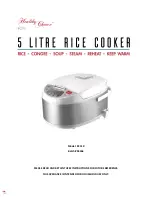
- 34 -
6. Operation
6.1 Functionality of induction cookers
With induction cooker, an electric voltage is applied on a conductor spool beneath the
glass. This creates magnetic fields, which directly heat up the bottom of the cookware
through a physical effect.
This means saving time and energy, because contrary to common hotplates, the
cookware is heated up, not the heating element and the glass.
Due to the technical characteristics described above, another advantage is the very
short start-up cooking time.
In addition, the heat supply promptly adapts to changed settings and can be controlled in
small steps. The induction cooker reacts to changed settings just as fast as a gas stove,
as the energy reaches the pot immediately without having to heat up other materials first.
The induction technology combines this fast reaction with the basic advantage of
electricity, meaning being able to exactly adjust the heat supply.
Additional advantages of an induction cooker:
•
As the cooking zone is only heated up indirectly via the bottom of the cookware,
over spilling food cannot stick. The glass cooking zone is only heated up by the
hot cookware.
•
If the device is turned on and no dish for cooking is present or is removed, a repeating
audio signal will sound and the device will turn itself off after approx. 30 seconds.
•
The device will detect if the appropriate cookware is placed on the heating plate.
If the cookware is not appropriate for induction hotplates, energy will not flow.
The device will turn off after approx. 30 seconds.
•
When operating the cooking zone with empty cookware, a temperature sensor turns
it off automatically.
6.2 Suitable and unsuitable cookware
Suitable cookware
o
Iron cookware;
o
Enameled iron cookware;
o
Steel or enameled iron pots / pans;
o
Cast iron pots / pans;
o
Stainless steel 18/0 and aluminum
cookware, if they are marked as
suitable for induction cookers (pay
attention to the description of the
cookware).
Summary of Contents for IK 27TC
Page 1: ...IK 27TC 105927 Original Gebrauchsanleitung V2 0120...
Page 2: ......
Page 4: ......
Page 166: ...162 1 1 1...
Page 167: ...163 1 2 8 8 8...
Page 168: ...164...
Page 169: ...165...
Page 170: ...166...
Page 171: ...167 60...
Page 172: ...168 1 3...
Page 173: ...169 2 2 1 2 2 2 3...
Page 174: ...170 3 3 1 3 2 3 3 3...
Page 177: ...173 5 5 1 5 10 5 2 16A...
Page 178: ...174 6 6 1 30 30 6 2 o o o o o 18 0...
Page 181: ...177 60 C 240 C 60 80 100 120 140 160 180 200 220 240 C 0 a LED 1 1 30 10 30 180 2 120...
Page 182: ...178 170 C 1 10 240 C 60 C 240 C 3 Standby 7...
Page 183: ...179 o o o o o 8 E01 E02 E03...
Page 286: ...282 1 1 1...
Page 287: ...283 1 2 8 8 8...
Page 288: ...284...
Page 289: ...285...
Page 290: ...286...
Page 291: ...287 60...
Page 292: ...288 1 3...
Page 293: ...289 2 2 1 2 2 2 3 WE...
Page 294: ...290 3 3 1 3 2 3 3...
Page 297: ...293 5 5 1 5 10 cm 5 2 16...
Page 298: ...294 6 6 1 30 30 6 2 o o o o o 18 0...
Page 301: ...297 60 C 240 C 60 80 100 120 140 160 180 200 220 240 C 0 LED 1 1 30 10 30 180 OFF 2 120...
Page 302: ...298 170 C 1 10 240 C 60 C 240 C 3 OFF Standby 7...
Page 303: ...299 o o o o o 8 E01 E02 E03...
















































